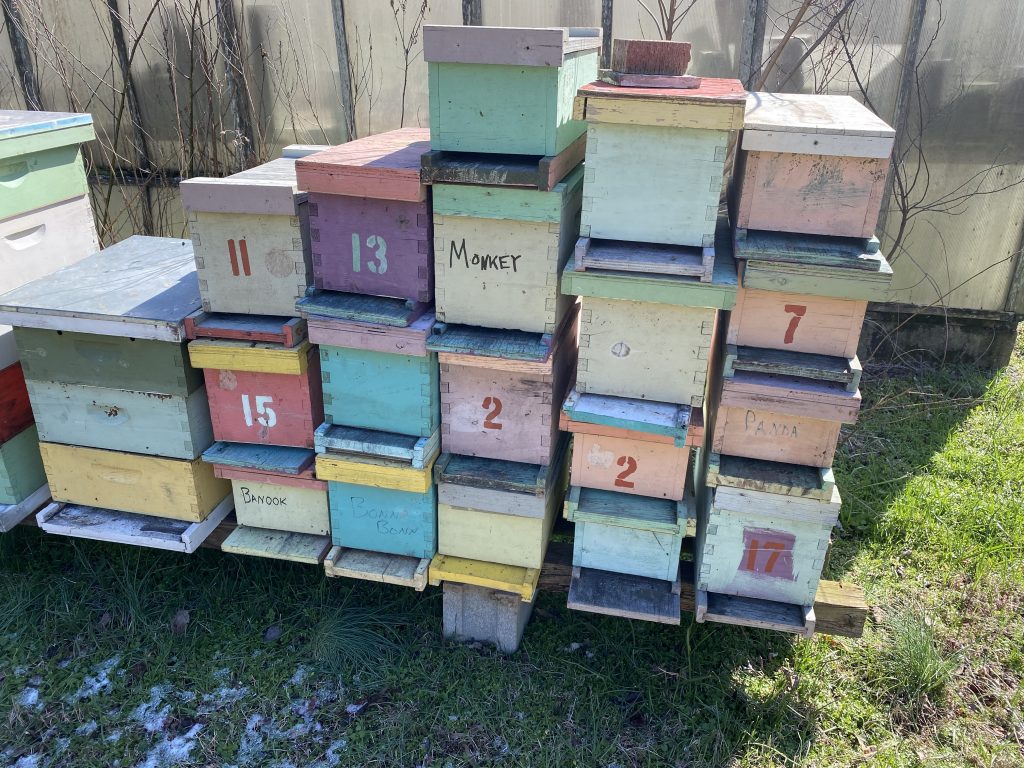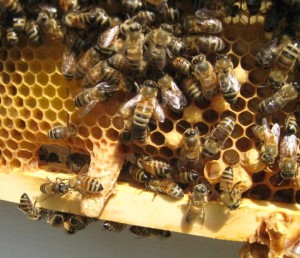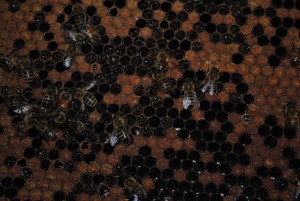It’s been a wild week or two. Beekeeping can be very relaxing – I believe that you can do just fine with very little maintenance (I think more folks are discovering this, which is why so many people are coming to the hobby now). I, however, am obsessed with the hobby and am always doing one thing or another. I can honestly say that there is always something that I could be doing (and frequently am!) It’s great to love your hobby.
We continue to have splendid honey bee weather to the east of Richmond, Virginia. Temperatures remain warm, rainfall is adequate (enough to keep the blooms full of nectar but not so much that it washes out the flowers frequently) and the bees are swarming. This year, I have begun to see a pattern in my hives – about 10 days before initiating several swarm cells, I find a PILE of capped drone brood, all over the place. I initially came across this in March with my strongest hives (Westover, Larry and Geronimo) and have now run across it in some of my ‘mediocre hives’ (these hives are great – they survive the Winters with my ‘no treatment’ philosophy, but they are not booming. They are targeted for honey production and as queen cell builders). I have had too many swarm situations, actually, and gave a few swarm cells to a fellow down the road from me who had lost both of his hives over the Winter.
It is important to note that I do not think it is the end of the world if your hive swarms. In fact, I support it if you do not treat (get those genes out into the wild – before I go to the great Beeyard in the sky, I hope to see plentiful, strong feral hives!) But, I just like to take advantage of the inclination to swarm and create new hives or replacement queens! So, I have been trying to keep on top of them every 10 days. I think that I only lost out on one swarm – the Little Bighorn Hive (an offshoot of Westover that was building up nicely, just not booming – I let 2 weeks pass between inspections and those devious little gals slipped one through the backdoor, it appears.)
As to re-queening, I have actually never done that before this past weekend. Albo was doing horribly. I checked her again last Friday and she had gone back to ONE frame of brood! For a history check, they had two frames of brood the first week of March and still only had two frames of brood the first week of April! Ha. That is truly pathetic. They were making it through the Winter (so they had some good genes), but I needed to get those genes out of my pool.
Nuc B held the Larry Queen. She is a 1 year old queen (this is her second season) and she is spewing out eggs like nobody’s business in the Nuc. I have 8 possible starts (actually, 2 are confirmed – see below!) off of that queen (not including the original hive, which I ‘think’ has a queen – will know in the next few days), so I decided to combine the Larry Nuc (I put her in a Deep, surrounded by 5 frames of foundation) with Albo. Of course, it rained the night before, which meant I had to haul the entire hive (Larry was now sealed up (duct tape, window screen and a strap) in a deep, bottom board, inner cover and telescoping cover) about a quarter of a mile – too muddy to drive up the hill to Mountcastles! Regardless, once I got up there, I found Albo’s queen and killed her, dropping it into an old film canister (anyone remember them?) with rubbing alcohol. This is for Queen Juice, something I will use for swarm catching (a later subject.) I then placed the Larry Nuc on the bottom and Albo on the top, a single layer of newspaper between them (which I had cut a few swaths in with my hive tool, to let air through.) Oddly, the queen was mid-sized. This had me wondering if they superceded the previous one – but, I have seen no cell in the last month. The hive has never been even a Honey Producer, so I wanted it removed anyway.
The goal here is that Albo will notice they do not have a queen within an hour. Soon thereafter, they’ll dig through to the Larry Nuc and start working with that queen. This weekend, I will combine them back to one Deep and let them build up normally. I doubt that I will get any honey off of this hive, but I am happy to get the Larry Gene down in the country (and be done with the Albo gene.)
My first swarm of the season, the Westcastle Hive, continues amazing build-up. In 10 days, they drew out 90% of a 10 frame Deep (they are going through about a gallon of syrup every other day – gotta feed those swarms!) I have put a Medium on them now, but noticed a couple of fishy looking queen cups (like they were starting to work them up a bit). It is not uncommon for a swarm to supercede a queen after they setup shop (and the beekeeper doesn’t really know how old the queen is anyway.) But, I am very impressed with the brood pattern of this queen. If they do cap those cells, I’ll take the queen for myself and let her run a Resource Nuc for me this year. The bees have not been terribly gentle since I got them, but I have not smoked them either. I definitely want a couple of queens (at least) off of this queen before they officially supercede her. I am a big fan of swarm queens (if you get the initial swarm, you have a queen that made it through the Winter – if you’re REALLY lucky, it was cast by a feral hive, which you KNOW has not been treated! Booyah!)
Finally, I have found capped brood in two of my initial Nucs from 3/19!! I actually have journal entries from both Nuc’s (A & C) on 4/15 saying ‘[color] queen found’ (one is black and one is dark brown) and ‘no sign of eggs’. There is no mention of my frustration, but I assure you that I was frustrated on 4/15. I expected to find brood somewhere! I was wondering if I had a bunch of sterile drones running around in the woods near my daggone Nuc yard! Either that, or I have very prude queens. More then likely, the bees raised new queens after my move, which would put the math more in line. Regardless, I have two Nuc’s (confirmed) that are laying. The goal now is to let them be for another week (let the brood mature) and then move them into a Deep. They get to go to a Deep if they have good brood pattern and are modestly gentle (I am not militant about that trait, at this stage.) I am tempted to put some feed on both of them to help them finish drawing out the two frames of foundation they both have left (both are about 50% drawn at this point.)



